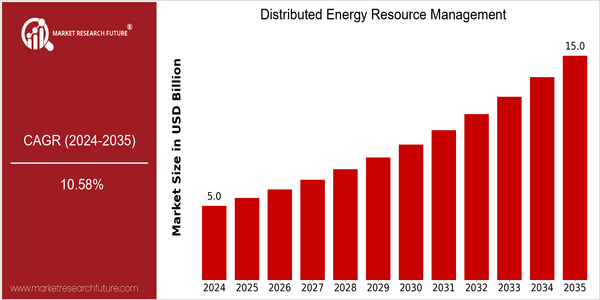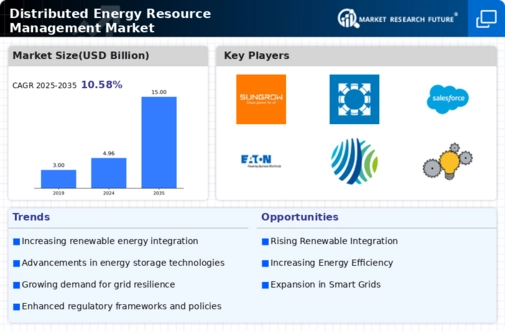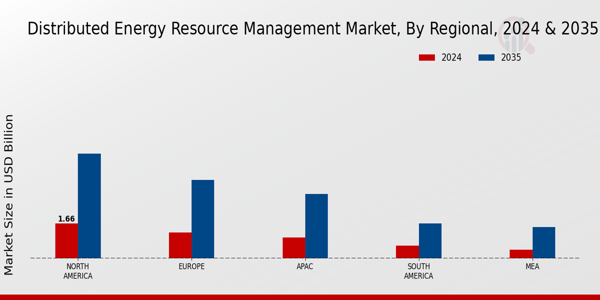Distributed Energy Resource Management Size
Market Size Snapshot
| Year | Value |
|---|---|
| 2024 | USD 4.96 Billion |
| 2035 | USD 15.0 Billion |
| CAGR (2025-2035) | 10.58 % |
Note – Market size depicts the revenue generated over the financial year
Distribution Energy Management Market is set to grow at a CAGR of about 21.6% between 2021 and 2035. This represents a strong CAGR of 10.58% between 2025 and 2035. The demand for energy efficiency and the use of renewable energy sources are driving this trend. DERs, such as solar panels, wind power plants and batteries, are increasingly being used by consumers and businesses. Also driving this growth is the development of smart grid technology, the improvement of energy storage systems and the development of energy management software. These innovations make it easier to integrate and optimize DERs, making them more accessible and efficient for end users. The major players, such as Siemens AG, Schneider Electric and Enphase Energy, are focusing on strategic initiatives such as strategic alliances and product launches to strengthen their position in the market. The collaborations, for example, are aimed at improving grid resilience and energy efficiency, thus driving the market.

Regional Market Size
Regional Deep Dive
The market for Distributed Energy Resources Management is experiencing considerable growth, driven by increasing demand for renewable energy sources, advancements in technology, and a supportive regulatory framework. In North America, the market is characterized by a strong focus on energy independence and the need for sustainable development, and a growing number of distributed energy resources (DERs) being connected to the grid. In Europe, the transition to a low-carbon economy is in full swing, with the European Union pursuing ambitious goals. Asia-Pacific is a major market for renewable energy, with China and India leading the way. The Middle East and Africa are gradually embracing DERs, driven by the need for reliable energy. In Latin America, the abundance of natural resources is driving the efficiency of energy generation and distribution.
Europe
- The European Green Deal aims to make Europe the first climate-neutral continent by 2050, driving investments in DER technologies and innovative energy management solutions.
- Germany's Energiewende policy has led to a substantial increase in decentralized energy generation, with a focus on solar and wind energy, influencing the overall DER management strategies in the region.
Asia Pacific
- China's National Energy Administration has set ambitious targets for distributed generation, particularly in solar energy, which is reshaping the DER management landscape in the region.
- India's Solar Rooftop Scheme is promoting the installation of solar panels on residential and commercial buildings, significantly increasing the deployment of DERs and enhancing energy access.
Latin America
- Brazil's National Electric Energy Agency (ANEEL) has implemented regulations to facilitate the growth of distributed generation, particularly in solar energy, enhancing market dynamics.
- Chile's energy policy encourages the integration of renewable energy sources, with a focus on distributed energy solutions to improve energy access in remote areas.
North America
- The U.S. Department of Energy has launched initiatives to promote the integration of DERs into the existing grid, focusing on enhancing grid resilience and reliability.
- California's Self-Generation Incentive Program (SGIP) has been instrumental in incentivizing the adoption of energy storage systems, significantly impacting the DER landscape in the state.
Middle East And Africa
- The UAE's Energy Strategy 2050 aims to increase the contribution of clean energy to the total energy mix, fostering the development of DER management solutions.
- South Africa's Integrated Resource Plan emphasizes the need for distributed generation to address energy shortages and improve grid stability, leading to increased investments in DER technologies.
Did You Know?
“As of 2023, over 80% of new power generation capacity added globally comes from renewable sources, highlighting the shift towards distributed energy resources.” — International Renewable Energy Agency (IRENA)
Segmental Market Size
DEMS plays a key role in the integration of distributed energy resources, storage devices and demand response systems in the power grid. This market is currently booming, driven by the growing demand for sustainable energy solutions from consumers and the positive regulatory frameworks for the reduction of greenhouse gas emissions. Also driving the growth of DEMS is the increasing share of renewable energies in the power system and the need for grid stability in the face of the challenges of climate change. DEMS is currently in the deployment stage, with leading companies such as Schneider Electric and Siemens deploying their solutions in various regions, including California and Germany. DEMS is primarily used to optimize the energy distribution of microgrids, increase energy efficiency in commercial buildings and support the charging of electric vehicles. This market is driven by macro-economic factors such as the drive for a green economy and the emergence of national and international regulations. The use of smart grids, which are based on artificial intelligence and blockchain, is also expected to be an important development trend in the near future.
Future Outlook
The DER market will see a CAGR of 10.58 per cent from 2024 to 2035, from a projected market size of $ 4.96 billion to $15.0 billion. This growth will be driven by the integration of more renewable sources, the technological development of storage systems, and the growing demand for energy-saving solutions. In the near future, with governments worldwide adopting policies and incentives to reduce carbon emissions, the penetration of DER such as solar panels, wind generators and battery storage systems will increase, leading to a higher level of penetration in both the residential and commercial sectors. Also, smart grids and big data analysis will help to manage and optimize DER. The rise of DER will also bring about a shift in the energy consumption and generation roles from producers to consumers. As a result, the growing trend of electrification in transportation and heating will also create new opportunities for DER, which will help to meet the rising demand for electricity. DER will also be able to meet the needs of the energy grid by generating electricity during peak hours and balancing the grid during off-peak hours. In summary, the DER market will continue to develop with the help of technological innovation, regulatory support and a shift in the energy market towards sustainable practices.
















Leave a Comment